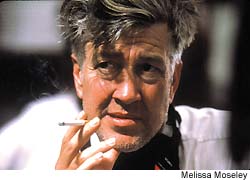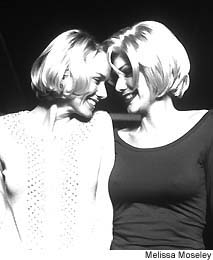

|
| Writer/director David Lynch creates a complex tale of suspense, set in the unreal universe of Los Angeles, in his new film 'Mulholland Drive.' |
"You can ask me, but I'm not going to tell you," replied Lynch, upbeat and positively jovial, when asked that question during a recent telephone interview. "All films are worked on for a long time, and they are worked on until the whole feels correct. That means every element feels correct. And then you put them out into the world, having done your job.
"And it is impossible to translate that into words again," he said. "It started as ideas and then goes to words in a script, but then it goes to the language of film, and that's what it's all about. So to go back to words again is a real heartache."
"Mulholland Drive" opened Friday at the Mayan Theatre.
Lynch, whose films and television projects have included "Eraserhead," "Blue Velvet," "Twin Peaks" and "Wild at Heart," likes to tell a story shrouded in unexpected plot twists, visual quirks and ominously bizarre imagery. "Mulholland Drive" lives up to that, and more.
Two mysterious women in Los Angeles (Naomi Watts and Laura Elena Haring) - both on the fringes of the film industry - find their very separate lives growing closer together, psychologically and physically. Why this is happening is not readily apparent to them, nor to us, although it may have a connection with a murder attempt. We search for a meaningful connection between them while they do, too.

|
| Naomi Watts (Betty) and Laura Harring (Rita) star in David Lynch's 'Mulholland Drive.' |
And that's just a sample. With "Mulholland Drive," which ultimately is deeply poetic and even epiphanic, there's always more than meets the eye. Even while it constantly is meeting our eye. Lynch, it appears, likes to try to be in touch with the subconscious.
"There's got to be a story that unfolds, but there are different layers to things," he explained. "It's just like real life - you see the surface but you sense much more. And when you sense things, I think you're using intuition. So while the surface is going on, it's pulling with it many layers that are beneath the surface, or above the surface or whatever.
"This beautiful language of film can show those things," he said. "A film is made up of many different elements, and when it's moving along properly, it's like a big orchestra.
"It uses time like in music, and it's using lots and lots of elements just like different instruments. It's critical to get all the elements to be correct, and that's a process that involves experimenting, based on the original idea."
Universal subconscious
Unsurprisingly, Lynch is interested in the dream state. In "Mulholland Drive," he appears to find a connection between each person's private one and Hollywood, itself, as a "dream factory." In fact, the film is being advertised as "a love story in the city of dreams."
He believes the dream state is part of the realism of existence. Thus, a film that tries to approximate that state is as "realistic" as any other kind of movie.
"We have waking, sleeping and dreaming - for most people that's what we deal with," he said. "So all of them are real, though the brain functions in a different way for each. We know about those things, or at least we know about dreaming and waking.
"And we know that when we're walking around we see the surface of things, but sometimes we sense something more, sometimes what we sense approaches a kind of dreamlike state," he said. "Those feelings take on a life of their own; they are just as real as anything else."
Lynch also uses music to conjure a dreamlike state. "Mulholland Drive" features an appropriately atmospheric score by Angelo Badalementi. It also features familiar, or vaguely familiar, pop tunes that have been hauntingly recast. ("Blue Velvet" was named after an old Bobby Vinton tune and famously features Dean Stockwell lip-syncing to Roy Orbison's "In Dreams." "Wild at Heart" uses Chris Isaak's extremely Orbison-like "Wicked Game.")
Silently singing
In one "Mulholland Drive" scene, a director auditions actresses on a sound stage. They are asked to lip-sync Connie Stevens' "Sixteen Reasons" and Linda Scott's "I've Told Every Little Star," early 1960s hits.
Later, in the film's most audaciously transfixing scene - staged by Lynch to drop-dead gorgeous effect - a chanteuse named Rebecca Del Rio performs Orbison's "Crying" in Spanish in an eerie late-night theater.
"Rebecca Del Rio with "Crying' is a strange accident," Lynch said. "She was never going to be in the film. My ex-music agent called me one day and said, "Would you like to meet her and maybe she can sing for you?'
"I have a music recording studio, and she came over, and four minutes after she got off the street she was in the booth and sang what is in the film," he said. "But I didn't know it would be in the film then. That was a happy accident.
"Strangely, it was the song "Crying' that led me to "In Dreams' in "Blue Velvet' years earlier. I heard "Crying' on the way down to shoot "Blue Velvet' and that made me start wondering if that would work in the film.
"So I got "Roy Orbison's Greatest Hits.' Then I heard "In Dreams' and that was the one that married into that film."
Lynch originally planned "Mulholland Drive" to be an ABC television series, like "Twin Peaks," and had even filmed a pilot.
"They hated it, but they never talked to me," he said. "They never called me or personalized the rejection in any way. It was through third parties. So I don't know the reasoning."
Instead, he began to consider turning his ideas into a feature film. "Just like Mulholland Drive, itself, this was a road full of turns," he said of the project. "There's a thing the surrealists did where they threw up random things in the air, studied what came down, and then got ideas from their random acts.
"In a way, this is the same sort of trick of the mind - starting out as an open-ended TV pilot and then taking a hairpin turn to a feature film."
Copyright 2001 The Denver Post
Back to the Mulholland Drive articles page.